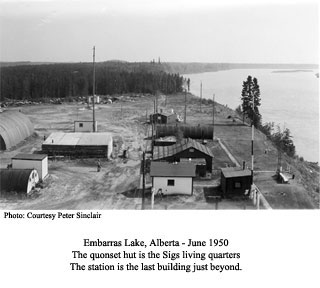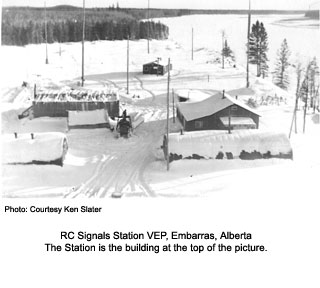|
By Peter Sinclair |
|
The
site manager had a section for airfield maintenance, mechanics to run the
generators and maintain the vehicles, some general duties personnel to
tote and carry and a kitchen staff of cook, cook's assistant, and another
to washup and tidy the dining room. At Wrigley we did all of that ourselves.
Embarras
will always be remembered throughout the NWT&Y as the Station who's
NOTAMs (Notices to Airmen) in late winter and spring always had as its last
sentence "Land with caution. Caribou on Runway".
For
many years the RCAF ran its float plane training school there. The school
was later transferred to Cold Lake.
McMurray Air Service flights enroute to Chipwyan and Beaverlodge were the highest percentage of the air-ground-air contacts. For some reason their aircraft could transmit voice on 3105 but did not have a high-frequency receiver. They tuned the ADF to our LF frequency. It was like 20 questions. We replied to questions with an "R" for yes and "N" for no. I think they were the only morse code letters they knew. The pilots could find if another of their planes had passed northbound or southbound, how long ago, and who was flying it.
We
tried to interest the NCO i/c, Sgt. Alex Burgess, but he was uninterested,
saying it was a hoax or an illegal transmission. We felt it should be brought
to the attention of Air Operations in Edmonton, but Sgt. Burgess disagreed.
However he did agree that we could send a message on our own if we insisted,
but any repercussions would be on our heads.
I
wrote out what we had and sent it off to XD Ops. This was followed by an
Air Ops CQ message requesting any info from other NWT&Y stations. We
were the only station to hear anything and that was only because we had been
listening to the Seattle broadcast station.
The
following morning, as soon as Alex unlocked the filing cabinet, Jack and
I got out the maps and found Spitfire Lake at that same Long. and Lat. reference
point. In mid morning a McMurray Air Service float plane came in enroute
to Beaverlodge. Over coffee I told the pilot about the message and pointed
out Spitfire Lake on the map. He said if he had time he would fly the extra
hour east of Beaverlodge to see what was there. This he did, and found am
RCAF Canso aircraft sunk in 15 to 20 feet of water with the crew on the wing.
Beaverlodge station made the report.
The Canso was on an independent task to get the precise Long. and Lat. of salient spots across the north to co-relate the air survey photos to maps. In taking off from Spitfire Lake the aircraft ran over a reef which ripped open its bottom. The crew were using a "Gibson Girl" emergency transmitter which should have been on 500 MHz instead of the 2nd harmonic where we picked them up. Had it been on 500 we would never had heard them as we did not monitor 500. Embarras
Station received a letter of thanks from the RCAF which Alex accepted as
his personal kudos.
As a sequal to this, in the mid-1970s I was with 704 Comm. Sqn. in Ottawa. The Ops O, Capt. Bill Nye, was visiting me in Rockcliffe and mentioned he was going to attend a retirement luncheon at the downtown Officers Mess. One of the retirees was an Air Force officer he knew who had been on an RCAF plane that had been sunk in the North. My ears perked up at that so I told him this story and said if this was the same aircraft then the retiring officer owed me a drink. Later Bill Nye phoned and said that officer had in fact been on that aircraft and would gladly buy the drink if our paths crossed. Ed Note: Spitfire Lake is at gridref: : 60,75 / 61°N - 107,5 / 108° W. |
|
|
|
Velox
Versutus Vigilans
|

